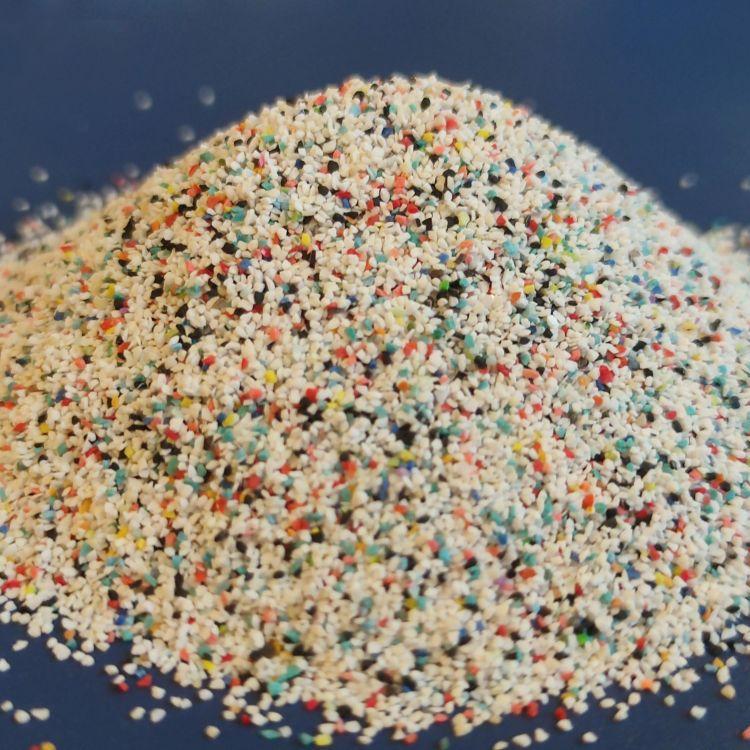Plastic Resin abrasive is a material widely used in surface treatment, mainly used for grinding and polishing soft metals and non-metallic workpieces. Its unique physical properties make it play an important role in many industries.
Definition and characteristics of resin abrasive
Resin abrasive, also known as resin grinding stone and plastic abrasive, is mainly made of abrasive sand and resin mixed in a certain proportion. Commonly used abrasives include silica powder, zirconium oxide, corundum sand and aluminum oxide powder. Compared with ceramic abrasives, resin abrasives have lower hardness and correspondingly reduced cutting force, which makes it easier to control the cutting force when processing precision parts, thereby avoiding damage to the workpiece surface.

Main features include:
Softness: Resin abrasive has good elasticity and can effectively reduce scratches on the workpiece surface.
Wide applicability: It can be used for surface treatment of soft metals such as aluminum, copper, zinc and non-metallic materials such as plastics and acrylic.
Low roughness: It can form low roughness on the surface of parts, suitable for pre-treatment such as anodizing, coating, and electroplating.
In which industries are resin abrasives widely used?
Resin abrasives are widely used in many industries due to their superior performance, including:
Machining: Resin abrasives are used in machining to remove burrs, flash and burrs, and improve the surface finish and precision of parts.
Automotive industry: In automobile manufacturing, resin abrasives are used to process a variety of parts, including transmission systems, suspensions and body parts, especially in the production of lightweight and energy-saving vehicles.
Aerospace: The aerospace field uses resin abrasives for cutting and polishing turbines, processing key components such as turbine blades to ensure their performance and safety.
Medical devices: In the manufacturing process of medical devices, resin abrasives are used for fine grinding to ensure the safety and reliability of products.
Electronic products: Resin abrasives are widely used in the electronics industry for surface treatment of electronic components, removing oxides and dirt, and improving product performance1.
Metal casting: Used in the metal casting industry, resin abrasives can remove oxide scale and impurities on the surface of castings and restore the original color of metals.
Jewelry: In jewelry manufacturing, resin abrasives are used for polishing and finishing to enhance the gloss and appearance of jewelry.
3D printing and powder metallurgy: Resin abrasives are also suitable for post-processing of 3D printed parts and powder metallurgy products to ensure that the surface quality meets the standard.
Household products: In the manufacture of kitchenware and other household products, resin abrasives are used for surface polishing to make the products more beautiful and easy to clean.
Grinding process and effect
The use process of resin sand abrasives is relatively simple. It is usually used in conjunction with professional grinding and finishing machines to achieve efficient mass production. Its main functions include:
Deburring: Effectively remove burrs and defects on the surface of product parts.
Descaling: Remove the oxide film on the metal surface and restore the original color of the metal.
Knife mark removal: Eliminate the knife marks left during machining without affecting the shape accuracy.
What is the service life of resin abrasives?
The service life of resin abrasives is affected by many factors, and there is usually no fixed standard wear time. Here are some key factors:
Use scenario: The service life of resin abrasives is closely related to the specific application scenario. For example, when processing workpieces of different materials (such as aluminum, copper, plastic, etc.), the degree of wear of the abrasive will be different1.
Shape and size of abrasive: Resin abrasives with sharp corners or edges have lower wear resistance and shorter service life than abrasives with smooth surfaces. In addition, large-sized resin abrasives are usually more wear-resistant and last longer than small-sized ones.
Hardness of the workpiece being ground: The hardness of the material being processed will also affect the service life of the resin abrasive. For harder materials, the abrasive will wear faster.
Operating conditions: Operating conditions such as grinding speed and pressure will also affect the durability of the abrasive. If you find that the grinding time has increased significantly or there are phenomena such as stuck holes and caulking, you may need to replace the abrasive with a new one.
Conclusion
Resin sand abrasives have become an indispensable part of modern industry with their unique physical properties and wide range of applications. By rationally selecting and applying resin abrasives, the surface quality and processing efficiency of the product can be significantly improved, and it is an important tool for achieving high-quality processing.
